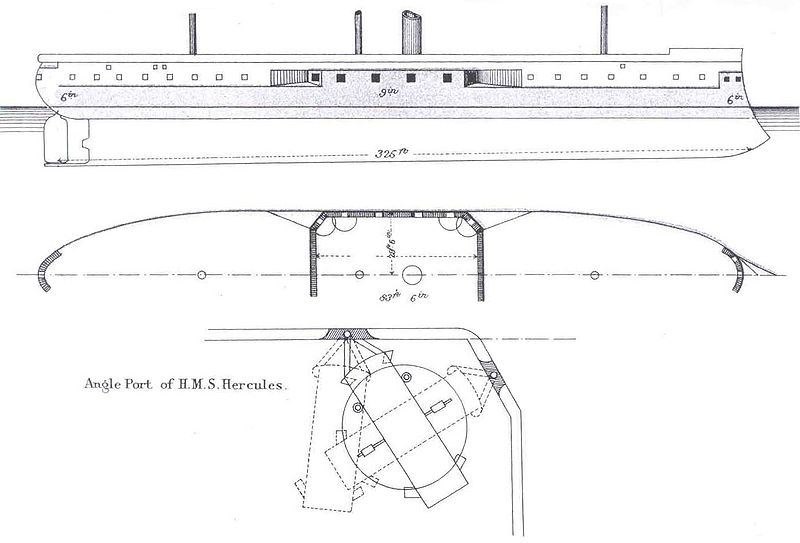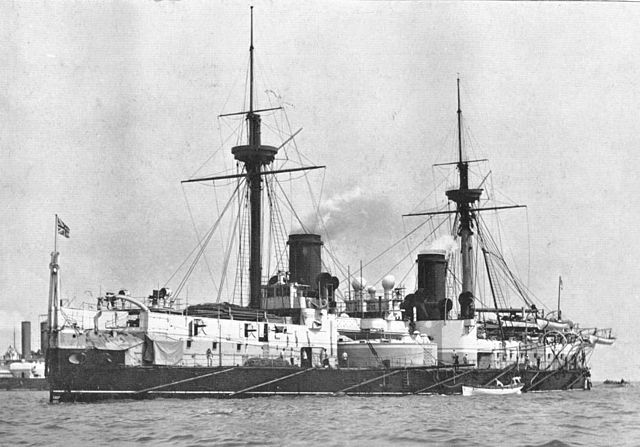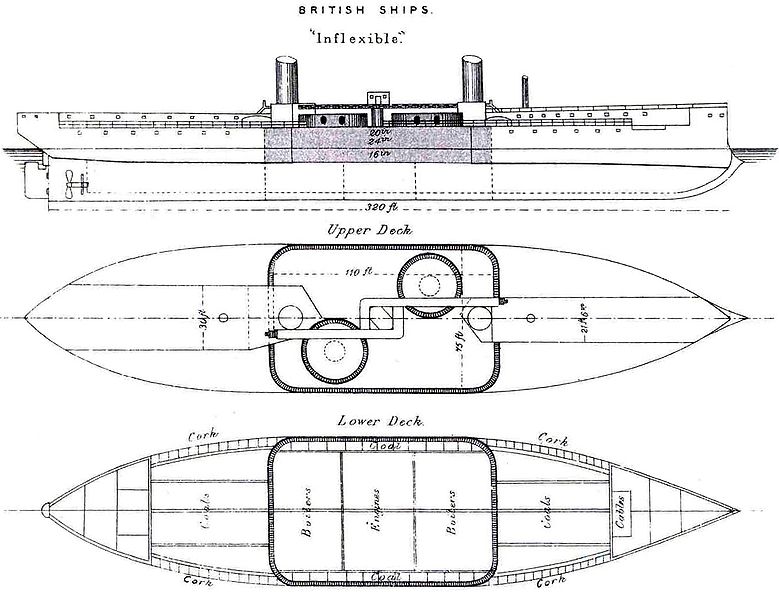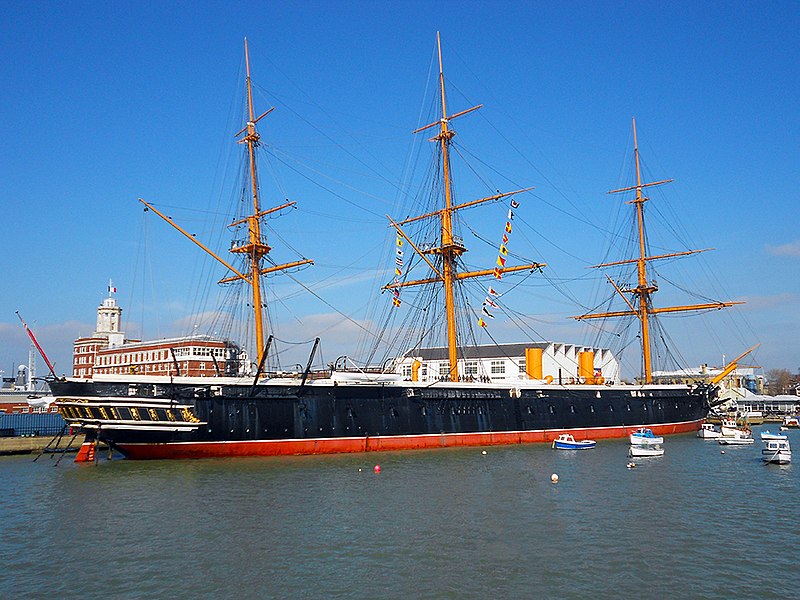The history of the armored warship between 1860 and 1890 is very confusing, particularly due to the lack of consistent nomenclature. I've done what I can to simplify it, but this is going to be messy.1
The first armored warships were built during the Crimean War at the behest of Napoleon III. He wanted ten floating batteries to attack the Russian defenses in the Crimea and the Baltic, but French industry could only produce five. The British built the other five, although only the French ships went into action before the end of the war, taking part in the Battle of Kinburn, where three of them destroyed a Russian fort in a matter of hours with minimal casualties to themselves. They were slow and hard to maneuver, but gave British and French designers experience that would be valuable when they embarked on proper seagoing ironclads.2

The French Ironclad Gloire
The first of these ships was the French ironclad Gloire, launched in 1859. She was wooden-hulled due to industrial limitations in France, and ultimately was a fairly conventional design.
The British responded with HMS Warrior, ordered in 1859 and launched in 1860. She was revolutionary, an iron-hulled vessel nearly twice Gloire’s size, and the fastest warship in the world at the time of her completion. Her armament of 40 guns was disposed much like the armament of a sailing frigate, laid out on a single gun-deck, and her 4.5" belt of wrought-iron armor was impervious to most guns at sea at the time. This type was known as the ‘broadside ironclad’ and was the mainstay of the ironclad until the development of the central battery with HMS Bellerophon in 1865.

HMS Bellerophon
Bellerophon had a broadside of 5 9”/250 pounder guns, as opposed to the 13 68-pounders and 4 110-pounders of Warrior, with the battery taking only a third of her length. The armor was concentrated around this battery, allowing thickness to rise to 6", with the ends protected by waterline belts covered with a protective deck. The biggest problem with the central battery was the lack of end-on fire, which was partially solved by providing alternate firing ports in the ends of the battery, through which the fore or aft gun could fire close to the ship’s centerline. These were not popular with crews or captains, as the muzzle blast tended to damage the ship.

Diagram of HMS Hercules, a slightly later central battery ironclad
The central battery didn't last very long as the prime layout of warships. Guns continued to grow, and inventors on both sides of the Atlantic worked to put guns in an armored, rotating mounting which soon became known as the turret. This gave improved protection, and allowed a few large guns to be used more effectively. The first combat use of the turret was at the well-known Battle of Hampton Roads, onboard the USS Monitor, designed by John Ericsson.3 In the UK, Cowper Coles had designed a slightly different turret, and it was his design which ultimately became the ancestor of the turrets of the dreadnought era. Unfortunately, Coles was also responsible for one of the biggest blunders in warship design of the 19th century.
The biggest problem with mounting a turret on a seagoing ship was that the inefficient steam engines of the time could not give a ship the necessary range, and a sailing rig was necessary. However, the masts and cables required interfered with the arcs of fire of the turrets.

HMS Monarch
The first attempt to solve this problem was HMS Monarch, designed by the Admiralty, with two twin 12" turrets between the fore and main masts. She was launched in 1868, and proved reasonably successful. However, Coles was not satisfied, and managed to convince many newspapers and politicians that his designs were superior and were being suppressed by a hidebound Admiralty. Public pressure grew to the point that the Admiralty was forced to fund a second ship, designed by Coles and built by a commercial builder. This ship, HMS Captain, had a complete upper deck over the turrets, with the rigging for the masts attached to it. As a result, the turrets were only 8’ above the water, as opposed to 16’ in Monarch. Captain did have slightly better arcs of fire, but suffered greatly in habitability, due to the loss of internal volume compared to Monarch.

HMS Captain
In September of 1870, shortly after she entered service, Captain was exercising with the fleet when a storm broke. The resulting heel caused Captain to capsize, with only 17 survivors of the 490 men aboard. Coles died with his ship, and thus was spared the inquiry, which determined that the original design was inadequate, with the center of gravity being about 8” higher as built than it was in the original design. Also, the ship had lost 22” of freeboard during construction, although a building error had resulting in her hull being 5” deeper than intended. This combination caused grossly inadequate stability, with a maximum righting arm of only about .2 m at 15 degrees, as opposed to .5 m at 40 degrees in Monarch. Despite the vindication of the Admiralty’s design standards, the key players were forced to retire, and Britain again failed to learn that politicians, the media, and the general public are usually very bad at making military decisions.4

HMS Monarch at sea
By the early 1870s, improvements in steam engines meant that it was possible to build ships without masts and sails, provided they were intended to stay reasonably close to home. At the same time, advances in guns and armor had made it possible for ships to attack coastal defenses with reasonable chances of success, opening up a new mission perfect for mastless ironclads. The result was the first really satisfactory turret ships, the breastwork monitors of the Devastation class. These ships were armed only with two twin 12" turrets fore and aft of the superstructure,5 an arrangement that would ultimately be used on the pre-dreadnoughts. In an attempt to make the ship a smaller target, the majority of the deck had very little freeboard,6 with the armored breastwork protruding to prevent the ventilators, uptakes,7 hatches and turrets from being swamped in bad weather. However, the guns were still mounted low, and suffered badly in a seaway. The debate over freeboard would continue until the early 1890s.

HMS Devastation
The problem with this arrangement was that the breastwork, being well inboard from the ship's side, did not contribute to stability, a subject of obvious concern after the loss of Captain. Devastation's breastwork was supplemented with a light structure carried out to the sides, which improved stability and habitability by giving the crew more room. However, this would have been rapidly riddled in action, and later vessels, such as HMS Dreadnought simply extended the breastwork to the sides of the ship.

HMS Dreadnought
Some missions still required endurance that could only be provided by sail, and a number of different design solutions were tried in an attempt to find an acceptable compromise. One, HMS Alexandra, was a fairly simple return to the central battery. Another, HMS Temeraire, was an unusual hybrid, combining the central battery with the first use of barbettes in British service.

HMS Temeraire
The barbette was a French innovation, an armored tub mounted on the upper deck of the ship, into which the guns retracted for loading. An armored tube ran down to the main armored deck near the waterline. Some navies placed thin (1-2") hoods over their barbettes, but the British left them open, trusting that the inaccurate and slow-firing guns of the day wouldn't take too heavy a toll on the gun crews.8 The Temeraire arrangement was not particularly successful, but the barbette would ultimately prove an important part of the pre-dreadnought story.

HMS Inflexible
The third ship to come out of the last effort to integrate sails was HMS Inflexible. She retained turrets, by now carrying 16" guns, but they were placed in a staggered arrangement, one on each side of the ship. This theoretically gave both turrets full fire ahead or astern on either side of the central structure that supported the masts and rigging, and a 4-gun broadside with the turrets firing through gaps in said structure. In practice, blast damage made this dubious, although the arrangement was repeated in several later ships. Inflexible had several other interesting features. Her great beam was intended to keep draught down and allow her to transit the Suez Canal. She also carried the first guns that I can find described as being for defense against torpedo craft,9 and her central citadel carried the thickest armor ever fitted to a British battleship, a full 24”. To allow for the weight of this armor, the waterline belt at the ends was eliminated, and a protective deck mounted below the waterline was used instead. Finally, she also marked the last use of a sailing rig on a British capital ship.

Diagram of HMS Inflexible
At this point, I’m sure the obvious question is why I haven’t mentioned any ships outside of the RN. There are three reasons for this. First, my sources on this era are British, and don’t give good coverage to other countries.10 Second, the road to the pre-dreadnought and ultimately the dreadnought is basically that of British development, with most branches from other countries ultimately dying off. Third, the development paths in most other countries were even less stable than those of the RN, which I’ve trimmed somewhat.11 The USN was basically doing nothing from 1865 to 1888, and the ships after 1888 are covered elsewhere.

HMS Collingwood
HMS Collingwood, lead ship of the Admiral class, laid down in 1880 and launched in 1887, brought many of these developments together. The guns were mounted in barbettes, allowing the guns to be carried higher, which in turn made them easier to fight, particularly in heavy seas. The main armament returned to the centerline, where it would stay. A strong secondary armament of 6” guns was mounted in a battery between the main turrets, along with numerous smaller guns for torpedo defense. Her vertical armor was limited to the waterline belt and the protection for the barbette hoists, with extensive protective decks. The rest of the Admiral class was similar, with variations in armament due to production problems that plagued British gunmakers of the time.
Traditionally, the next two classes are considered to have been steps backwards, as they were low-freeboard turret ships. However, each one pioneered an important design element that would later become part of the pre-dreadnought.

HMS Victoria
HMS Victoria is most famous for her death at the hands of a friendly ram, although her main armament of a single turret carrying two 16.25" guns is also rather well-known.12 These massive weapons, which took 3 minutes to fire each shell and had a barrel life of only 75 rounds, were not a success, but Victoria pioneered an important development. Previously, all turrets had been placed directly on top of the citadel, while Victoria, for the first time in a British ship, elevated them above the armored deck on what they called a redoubt and we would now describe as a barbette. This isn't widely recognized, as Victoria had only one turret, but a diagram in Oscar Parke's British Battleships shows a two-turret ship with this arrangement as one of the options considered for what became Victoria. This was an important innovation, as the topweight requirements to raise a turret on a redoubt/barbette are much smaller than those required if you have to raise the entire citadel. Victoria also pioneered the triple-expansion engine in RN service, an important step in improved fuel economy.

HMS Trafalgar
The next class, Nile and Trafalgar, introduced quick-firing (QF) secondary armament. Their 4.7" guns fired single-piece ammunition, which, combined with improvements in gun mechanisms, took the rate of fire to as much as 10 rounds per minute, as opposed to 4 rpm in the 6" guns of the Admiral-class. However, they returned to placing the turrets on top of the citadel, probably in a last attempt to reduce freeboard and target profile.13
By the late 1880s, all of the elements were in place for the pre-dreadnought, which would usher in a period of stability in battleship design, and bring an end to the wild experiments that marked the first 30 years of the armored ship. The vessels that were built during this period are mostly forgotten. They saw action only once, during the bombardment of Alexandria, and it's much easier to ignore them than to try to make sense of them. Despite this, they laid the technical foundations for the later battleships, and gave the men who would design and command them their start at sea.14
1 Thanks to Johnnie Lyle for reviewing this post, and forcing me to rewrite it instead of posting the old version. ⇑
2 It should be pointed out that these ships bear more than a passing resemblance to CSS Virginia, commonly known as Merrimack, her name in USN service. However, these ships were considerably smaller and more heavily armed. In fact, all of the Civil War ironclads were much more similar to these ships than to the later battleships I'm covering here. ⇑
3 Because I'm focusing on the seagoing capital ship, I'm going to ignore Monitor and the other ironclads of the American Civil War. ⇑
4 This is not to single out Britain as a particularly bad example of this problem. It probably dates back to the procurement of war rocks and sticks during the paleolithic, and continues to be a problem worldwide today. ⇑
5 Monarch and Captain had each carried 3 7" guns in addition to their turrets to provide fire fore and aft, where their turrets could not bear. ⇑
6 Freeboard is the height from the waterline to the deck. ⇑
7 The naval term for engine exhausts. ⇑
8 Some of them also labored under the belief that being unable to see the target would seriously hinder the morale of the gun crew. For more discussion of barbettes see here. ⇑
9 The same battery is described in some earlier ships as ‘saluting guns’, however. ⇑
10 Since this post was originally written, I've expanded my library and now have much better coverage of other navies, but coverage of them is going to be in the book I'm working on. Russia has been dealt with separately. ⇑
11 For instance, I haven’t even mentioned the armored rams. ⇑
12 The secondary armament was 1 10" and 12 6" guns. ⇑
13 A desire for more armored freeboard may have played a part, too. ⇑
14 Jackie Fisher was the first Captain of Inflexible, while John Jellicoe was 2nd in Command of Victoria when she was sunk. ⇑


Comments
Many of the links in this post are busted, because you're dropping the parentheses in Wikipedia urls. (HMSTemeraire1876 instead of HMSTemeraire(1876)).
Most of these ships saw limited/no action, right? Do you think more active combat would have changed design in this era? That is: were they doing dumb and silly things because we really hadn't come up with good ways of doing things, or just because no one had fought the ship and realized "oh wait, this is a terrible gun arrangement when it actually matters?"
The story of Captain reminds me; I'm vaguely curious about some of the details of how ships stay upright. How is their resistance to capsizing measured, and what factors of the ship's design affect it?
@Andrew
The broken links are because PMWiki doesn't handle parenthesis in URLs well, and I forgot to fix them manually.
The only action I'm aware of that any ship I discussed here saw was the Bombardment of Alexandria.
Yes to all.
Combat would have definitely changed things, although in what direction, it's hard to say. Lissa gave us 40 years of ram bows, even though ramming was probably stupid even then. (I'm not as sure as most on this, but it wasn't a brilliant idea even in 1866.) Maybe the war is fought in calm seas, and low-freeboard ships dominate. Maybe it's fought as a close-quarters melee for some reason, and so everyone is focused on turrets. We can't be sure that the conclusions they'd draw are the ones we'd draw today. (See Lissa.)
The other issue that I didn't dwell on is the one of sequence. (This was deliberate. This post is design history. British naval policy is related, but really needs to be separate, and I have higher priorities.) After about 1870, the building rate plummeted. Ships would take 6-7 years to build, and there weren't a lot of them. So experience took a long time to trickle back to the designers, and the two or three classes which were affected were a significant fraction of the fleet.
Lastly, this was one of the first technological revolutions. At the time, warships were the pinnacle of technology. You're suddenly overthrowing the established order, and they didn't have the conceptual tools necessary to figure out how to deal with it well. These days, we have a better idea how to go about figuring out how to apply technical developments, but they didn't have the conceptual tools we do.
@Protagoras
Look up the term Metacentric Height. Stability as a topic has been creeping onto my list, and it's going to take a full post to answer your question properly.
@bean:
You will now find, in your edit toolbar, a new button that will properly URL-encode a selected URL for you (converting “(” into “%28” and so on). So for stuff like
that will properly URL-encode a selected URL for you (converting “(” into “%28” and so on). So for stuff like
https://en.wikipedia.org/wiki/HMS_Temeraire_(1876)just select such a URL and click this button.Cool, thanks. I meant to do it, and it just slipped my mind.
Another great post that was really improved by the pictures! Maybe I'm just partial to the Victorian-style color paintings :P
Is that why HMS Inflexible was the first designed to be able to cross the Suez, even thought the canal was completed in 1859? It seems like after all the trouble to build the canal the British would want to be able to move military strength through it ASAP.
@quaelgit
The British didn't build Suez. The French did, and the British actually tried to start a revolt among the workers on the project. Also, the Canal didn't open until 1869, while the British bought in in 1875, and got control during the 1880s. Parts of that story may come up here.
Suez draft was a specific characteristic of some British warships up until 1905 or so. I know the Canopus-class pre-dreadnoughts were specially designed to do so, too. I didn't re-research Inflexible's draft (it's about the one thing that just carried over), so I can't speak to the drivers there offhand.
"Lastly, this was one of the first technological revolutions. At the time, warships were the pinnacle of technology. You're suddenly overthrowing the established order, and they didn't have the conceptual tools necessary to figure out how to deal with it well. These days, we have a better idea how to go about figuring out how to apply technical developments, but they didn't have the conceptual tools we do."
Were these tools better applied in the shift to dreadnaught ships or to aircraft carriers?
Very much so. There were a few false steps, but the designers were able to zero in much more effectively on what would and wouldn't work. And you rarely saw truly retrograde steps, like with the reintroduction of the central battery. The only one that springs to mind offhand is the reintroduction of superimposed turrets, and they hadn't been to sea on the Kearsages when they were selected for the Virginias.
(I'm in the process of revising my post on pre-dreadnoughts, but it probably won't make it into the queue this year.)
@bean re: Suez
Thanks for the correction. "1859" was a typo but I had completely misremembered the history of the canal.
One additional problem I just read about for the old wood or composite steam ships. The heat from the engines promoted new and exotic forms of dry-rot.
That seems entirely plausible. I remember hearing about dry rot in some of those ships, but it wasn't connected to the heat from the engines. That was far from the only issue, and it's surprising wood lasted as long as it did.
You seem like the right person to ask on this. I recently came across an extensive listing of the “turning power” of foreign ironclads in the 1887 Brassey’s. As someone returning to an attempt to design wargame rules for the ironclad era, this was a gold mine. I hoped that a similar table for RN ships might be on a different page, but if so, it’s well hidden, and other years available online have nothing similar.
I’m wondering if you know of similar tabulations. Brassey’s has a few others scattered about. Attwood’s “Warships: A Textbook” has a smattering of later RN cruisers (by which time the modern “tactical diameter” term is used), Reed’s “Our Iron-Clad Ships” covers the earliest RN examples and old-navypedia has the 1877 French Tourville listed. Luce’s “Text-Book of Seamanship” includes some American wooden vessels and an RN gunboat that could supposedly turn inside its own length (I suspect unit confusion), also listing worthwhile rules of thumb. An appendix here tantalizingly mentions “German Admiralty Pamphlet No. 37”, detailing experiments over a broad range of vessels, but I’ve had no luck turning that up.
Any help would be appreciated, and I’m looking forward to exploring your site further.
Unfortunately, I can't think of anything. I'm sure I've seen occasional figures for turning circles, but I can't recall seeing a big table anywhere.